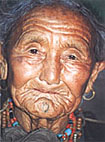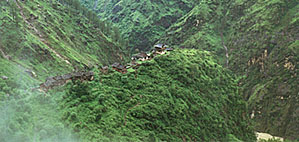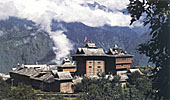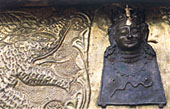| PETERVANHAM.COM BIOGRAPHIES BOOKS MUSIC / FILM PUBLICATIONS & LECTURES NORTHEAST INDIA WESTERN HIMALAYAS PHOTO-ARCHIVES UPCOMING CONTACT |
|||||
KINNAUR


Kinnaur, the land of the mythological Kinnaras is a deeply laced-in terrain along the Sutlej River with many side valleys, by which the district is thoroughly divided. Due to its geographical setting, Kinnaur has two distinct climatic zones - the wet and the arid. Only the area south of the Great Himalaya (Sutlej and Baspa valleys) receives monsoon rains. In the upper reaches of the district, the monsoon showers progressively decrease and one can notice the beginning of the completely arid zone from Spello and Kanum at a distance of 255 kms from Shimla.
Recong Peo, the district headquarters may be considered as a place where the Great Himalayan range obstructs the march of the monsoon. From this point on the vegetation rapidly becomes sparser ultimately to remain only along the Sutlej river. The harsh winter with heavy snowstorms lasts from October to May leaving only June to September for the short summer and vegetation to grow. The total area of this great and peculiar landmass called Kinnaur is 6553 square kilometres with a total population of 60.000 which leaves an average of 9 persons per square kilometre.

Kinnaur, the ancient Kinnerdesh, is the home to a unique alpine culture. A rare style of wood architecture finds its climax in the temple of Sarahan, located at the border between the Shimla hills and Lower Kinnaur.
The southern area of Kinnaur may be regarded as a transition zone between Hinduism of the Indian plains, a unique animism of local kind - especially snake worship - and Buddhism, prevalent in the hills. At the village of Pooh, one enters the cultural realm of Tibet. Had it been permitted by the authorities, one could traverse along the Sutlej straight on to the ancient Tibetan kingdom of Guge, such as Tucci did.
Although the climatic conditions may be considered as extremely hard the people of Kinnaur are well-acclimatised to their surroundings bearing strong yet fine natural features and characteristics typical for all mountain folks. In the regions below Kalpa their faces reveal Persian influences which may be derived from the armies of Alexander the Great having reached as far as here and having settled and mixed with the locals. In the northern areas the Tibetan features dominate. Therefore also the habits vary south and north of this ”monsoon-border”, both being equally unique, not only in architecture but also in languages of their own and a rich heritage of folk and fairy tales, songs, dances, festivities, fairs, costumes and ornaments.



• Sarahan temple
• Chini village and temple (8th century) / View of Kinner Kailash
• Sangla / Baspa Valley with the villages of Kamru (fort)
and Chitkul (3450 metres)
• Kanum & Labrang villages (ancient library)
• Ropa Valley (11th century temple in Ropa)
• Nako village (beautiful Tibetan village with a lake and an 11th century temple
at 3700 metres height)
• The people and the landscape
All these highlights and more are the subject of three books by Peter van Ham:
BUDDHA´S MOUNTAIN DESERT
The Secret Tibetan Heritage in the Himalayas
THE FORGOTTEN GODS OF TIBET
Early Buddhist Art in the Western Himalayas
ON THE PATHS OF THE BUDDHA
2000 kms through the Western Himalayas (in German language)
petervanham.com pages on
the Western Himalayas:
SPITI, TABO MONASTERY, LAHAUL, CHANGTHANG, NUBRA